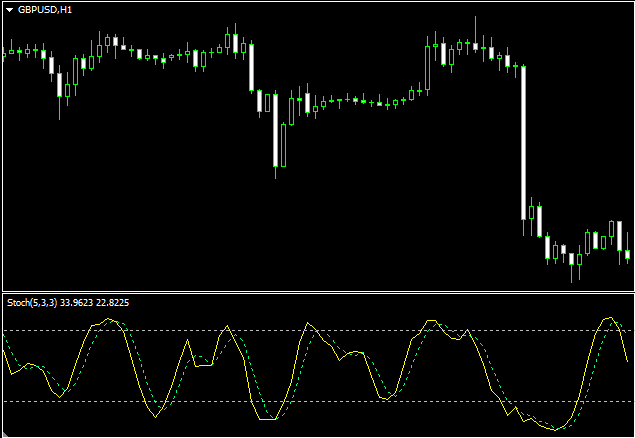What is the Stochastic Oscillator?
The Stochastic Oscillator is an indicator that compares a security’s most recent closing price with the highest and lowest prices over a specified period of time. It gives readings that range (oscillate) between zero and 100 to provide an indication of the security’s momentum.

Stochastic metrics are essentially percentage expressions of the trading range of a security over a given time period. (The default setting for the Stochastic Oscillator is 14 time periods – hourly, daily, etc.) A reading of 0 represents the lowest point of the trading range. A reading of 100 indicates the highest point during the specified time period.
Stochastic Oscillator Formula
The formula for calculating the Stochastic Oscillator is as follows:
%k = (Last Close – Low)/(High – Low) x 100
%D = 3 day SMA of %K
Where:
- C is the last closing price
- The lowest low is the lowest low for the time period
- Highest High is the highest high for the time period
Oscillator history
Dr. George Lane developed the Stochastic Oscillator in the late 1950s for use in the technical analysis of securities. Lane, a financial analyst, was one of the first researchers to publish research papers on the use of stochastics. He believed that the indicator could be used profitably in conjunction with Fibonacci retracement cycles or Elliot wave theory.
Lane noted that the Stochastic Oscillator indicates the momentum of a security’s price movement. It is not a price trend indicator as, for example, is a moving average indicator. The oscillator compares the position of a security’s closing price relative to the high and low (maximum and minimum) of its price range over a specified time period. In addition to measuring the strength of price movement, the oscillator can also be used to predict market reversal points.
Uses of the Stochastic Oscillator
The following are the main uses of the stochastic oscillator:
Identify overbought and oversold levels
An overbought level is indicated when the stochastic indicator is above 80. Indicators below 20 indicate oversold conditions in the market. A sell signal is generated when the oscillator reading goes above the 80 level and then returns to readings below 80. Conversely, a buy signal is indicated when the oscillator moves below 20 and then above 20 again. The levels overbought and oversold mean that the security’s price is near the top or bottom, respectively, of its trading range for the specified time period.
Deviation
A divergence occurs when the security’s price makes a new high or low that is not reflected in the Stochastic Oscillator. For example, the price moves to a new high but the oscillator does not correspondingly move to a new high. This is an example of a bearish divergence, which can signal an impending market reversal from an uptrend to a downtrend. Failure of the oscillator to make a new high during the price action indicates that the bullish momentum is beginning to wane.
Similarly, a bullish divergence occurs when the market price makes a new low but the oscillator does not follow suit by moving to a new low. A bullish divergence indicates a possible impending market reversal to the upside.
It is important to note that the Stochastic Oscillator can give a divergence signal just before the price action changes direction. For example, when the oscillator gives a bearish divergence signal, the price may continue to move higher for several trading sessions before turning to the downside. This is why Lane recommends waiting for some confirmation of a market reversal before entering a trading position. Trading should not be based on divergence alone.
Crossovers
Crossovers refer to the point at which the fast stochastic line and the slow stochastic line intersect. The fast stochastic line is the 0%K line and the slow stochastic line is the %D line. When the %K line crosses the %D line and goes above it, this is a bullish scenario. Conversely, the %K line crossing above and below the stochastic %D line gives a volatile sell signal.
Limitations of the Stochastic Oscillator
The main disadvantage of the oscillator is its tendency to produce spurious signals. They are especially common in turbulent, highly volatile trading conditions. This is why the importance of confirming trading signals from the Stochastic Oscillator with indications from other technical indicators is emphasized.
Traders should always keep in mind that the oscillator is primarily designed to measure the strength or weakness – not the trend or direction – of price movement in a market.
Some traders aim to reduce the Stochastic Oscillator’s tendency to generate false trading signals by using more extreme oscillator readings to indicate overbought/oversold conditions in a market. Instead of using readings above 80 as a cutoff, they instead interpret only readings above 85 as overbought. On the downside, only readings of 15 and below are interpreted as signaling oversold conditions.
While adjusting to 85/15 reduces the number of false signals, it can cause investors to miss out on some trading opportunities. For example, if during an uptrend the oscillator reaches a high of 82, after which the price turns down, a trader may have missed an opportunity to sell at an ideal price because the oscillator never reached the required overbought indicator level. 85 or above.
If you don’t like the template Thoughtful Oscillatoryou can try it Advanced Stochastic Scalper:
A final word about the oscillator
The Stochastic Oscillator is a popular, widely used momentum indicator. Traders often use oscillator divergence signals to identify potential market reversal points. However, the oscillator is prone to generating spurious signals. Therefore, it is best used in conjunction with other technical indicators, rather than as a stand-alone source of trading signals.

